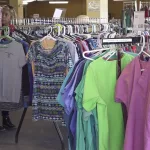
BURLINGTON, Vt. (WCAX) – Sustainable fashion is becoming more popular and more important.
“Clothes are not trash unless they are wet or moldy but, on average, a person throws about 80 pounds of clothing a year away which is… it’s tragic,” said Heather Steeves of Goodwill Northern New England.
Thrift stores in downtown Burlington are seeing more customers as many move toward secondhand styles.
“I love the thought of being able to rotate your wardrobe but if you can do it sustainably by shopping second hand, in my opinion, that’s a much better way to go than just to keep buying new stuff and then throwing it out,” said Anya Huneke of Dirt Chic.
The owner of Battery Street Jeans says they work to promote sustainability; they have a free clothing bin right outside of their store where anyone can donate and pick up clothing.
“Clothing waste is a huge contributor obviously to pollution waste on size,” said Isaac Dow of Battery Street Jeans.
Dow says he does anywhere between two to 10 drop-offs a day. He encourages people to not throw away their old clothes, as does Tom Longstreth of ReSOURCE.
“I think what’s exciting is I just love seeing people come into ReSOURCE locations who are hip, who are fashionable and who just find and repurpose and recreate their own fashions that fits their own character and their own styles,” Longstreth said.
At ReSOURCE in Williston, there has been substantial growth of the reuse of clothes and other items. Last year, they managed nearly $2.8 million in reuse sales with 778,395 items sold. Longstreth says that means 818.4 tons of material diverted from landfills.
“We’re trying to promote the idea of the ripple effect and really what we mean by that is every single person can take small actions that we think eventually over time are going to start building up into a wave of environmental activism,” Longstreth said.
Experts say in the last 15 years, clothing represents more than 60% of the total textiles used. And while production has doubled, the use of clothing declined by almost 40%.
“We have one earth and we’re living in a world of fast fashion that is demanding on the planet, its water, its resources,” Steeves said. “If we can keep fashion circular and not even just fashion, our household goods circular– meaning we’re buying them secondhand and when we’re done wth them redonate them– it cuts out a lot of these problems.”
